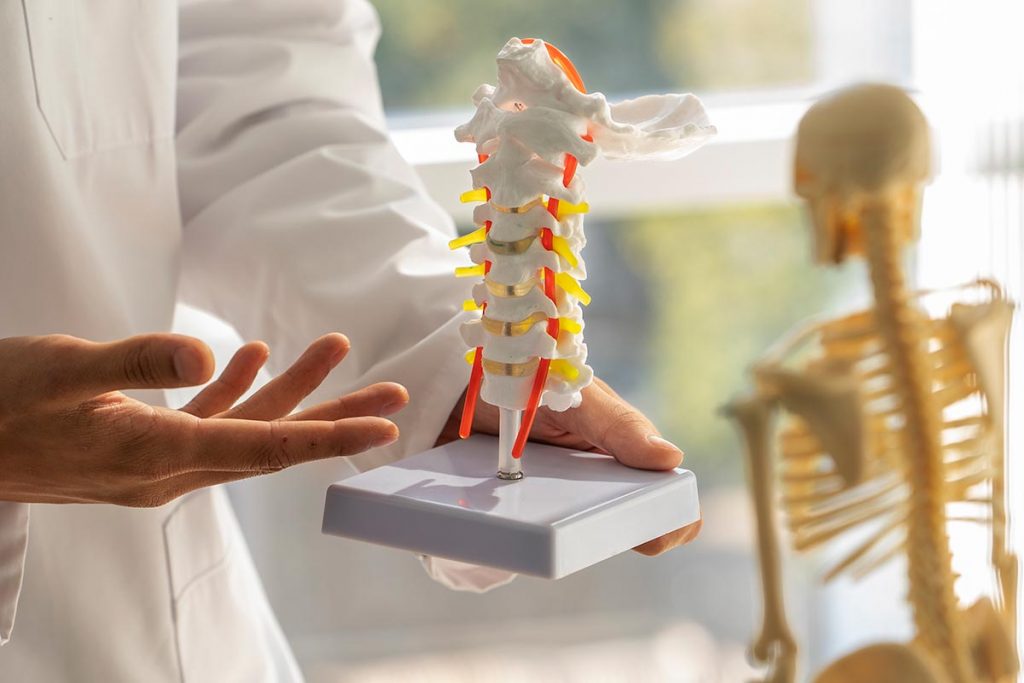
Table of Contents
The spine has nerves that exit through the holes in the spine’s bones on each side and at each level of the vertebrae. The holes are called foramen and allow nerve messages to travel to the periphery. These nerve roots are called radicular nerves because they branch out or radiate into other body parts. Where the nerves originate in the spinal column determines where they travel. It also impacts where pain is experienced, including unexpected areas, like back pain affecting the front of the torso.
Conditions Causing Nerve Root Pain

Radicular pain is any pain that radiates due to nerve compression or inflammation of one or more nerves. Compressed nerves are referred to as “pinched nerves.”
Radiculopathy is the name of a condition in which a nerve root is pinched or compressed in the spine and produces a set of symptoms.
Radiculopathy applies to all sections of the spine.
1. Cervical Radiculopathy
Cervical radiculopathy refers to the compression or inflammation of a nerve in the neck. Pain can occur in the shoulder and arm the compressed nerve serves. Sometimes, this is difficult to diagnose, requiring a combination of the doctor’s exam, your medical history, and some tests like an MRI or CT scan.
2. Thoracic Radiculopathy
Thoracic radiculopathy is a condition in which there is a compressed or inflamed nerve in the thoracic spine, which is in the middle of the back below the neck and above the lower back. It is considered the least common type of radiculopathy, which may be due to a lack of diagnosis for many years.
Today, it is known that different conditions, including spinal stenosis, disc herniation and bone spurs cause thoracic radiculopathy. The pain can be a sharp pain in the chest or back, but this type of radiculopathy can cause pain or numbness that wraps around the body’s front, causing chest or abdominal pain. It is also known to cause dermatome pain, which is tingling or pain in the skin in the pinched nerve area. The location of dermatome pain can help the doctor identify the affected nerves. This is another uncommon type of radiculopathy.
3. Lumbar radiculopathy
The most common type of radiculopathy occurs in the lower back. Nerve roots are compressed or irritated in the lower back due to lumbar disc herniation, narrowing of the foramen (hole where the nerve exits) and vertebrae degeneration, like spinal stenosis and spondylolisthesis. Lumbar radiculopathy is a common condition causing chronic back pain, and the pain may radiate into the legs. Other possible symptoms include numbness or weakness in the areas the nerves serve.
It may get confusing because radiculopathy is not the same as radicular pain. They often happen together, but not always. Radiculopathy, the condition of a compressed nerve, can occur without pain. Radicular pain is a symptom that can occur when radiculopathy is not present.
What is Radiculitis?
Radiculitis is not a medical condition. It is the term for the symptoms people experience from pinched, inflamed, compressed or irritated nerve roots where they exit the spinal column. It is also called sciatica, when the nerve that branches from the lumbar spine radiates pain down and into the legs. The typical symptoms of radiculitis include the following.
- Pain that radiates along the path of the nerve
- Numbness
- Tingling
- Muscular weakness
- Loss of reflexes
- Sensation of pins and needles
The reason radiculopathy is challenging to diagnose is because the pain is radiating, making it harder to identify the source, and it may occur at the same time another medical condition exists. For example, radiculopathy may overlap with peripheral neuropathy. Neuropathy can involve nerves outside the spinal cord, while radiculopathy refers to nerves in and exiting the spinal cord.
Causes of Radiculopathy
There are various causes of radiculopathy in which a nerve root is pinched or inflamed. They include the following:
- Disc herniation
- Bone spurs
- Arthritis
- Ossification of spine ligaments
- Spinal nerve inflammation
There are rare causes of radiculopathy, like sarcoma, which is cancer within tissue.
Never Ignore Symptoms

It is imperative to see a doctor if any of the radiculitis symptoms are experienced. Sometimes, radicular pain is not experienced early in the spinal condition and only develops as the radiculopathy advances, like in disc herniation. As mentioned, sometimes, there is no pain, but there may be other troublesome symptoms like numbness. Explaining early symptoms like tingling or numbness will help the doctor determine the best strategy for identifying the cause. Early detection will enable the development of a treatment plan addressing the cause of the radicular pain as soon as possible.
Sources
- https://www.painphysicianjournal.com/linkout?issn=1533-3159&vol=5&page=372
- https://onlinelibrary.wiley.com/doi/10.1111/papr.13252
- https://www.physio-pedia.com/Thoracic_Radiculopathy
- https://www.ncbi.nlm.nih.gov/books/NBK430837/
- Bogduk N. On the definitions and physiology of back pain, referred pain, and radicular pain. Pain. 2009 Dec 1;147(1):17-9
- https://www.ncbi.nlm.nih.gov/pmc/articles/PMC4951374/
